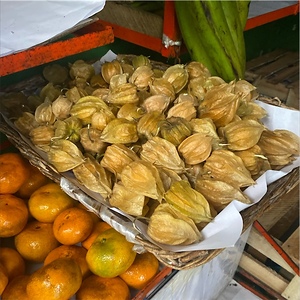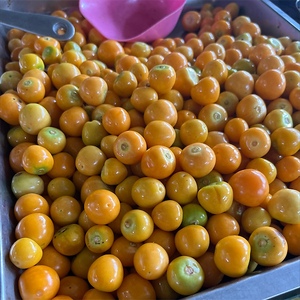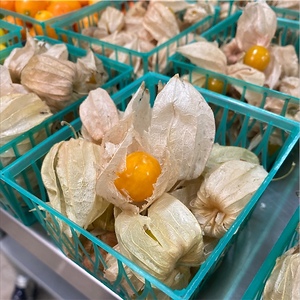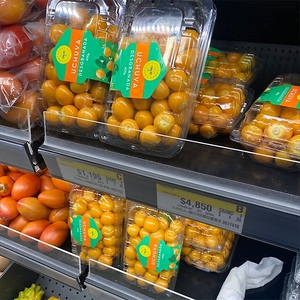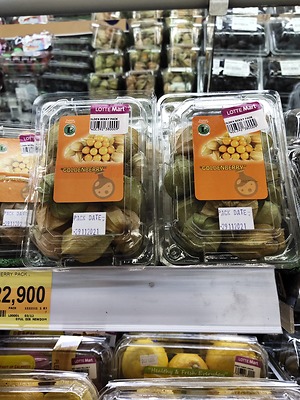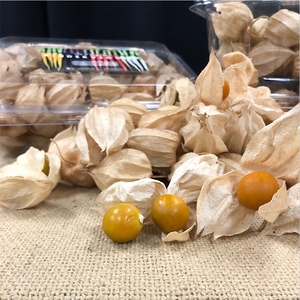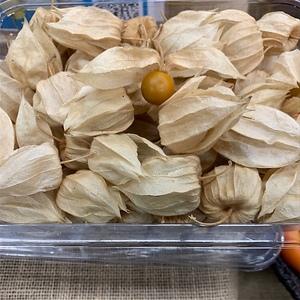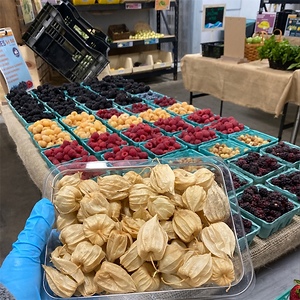


Pichuberry® Gooseberries
Estimated Inventory, lb : 0
Description/Taste
Pichuberries® are globular fruits, averaging 1 to 2 centimeters in diameter, and are encased in a tan, papery husk that forms a delicate and tapered, lantern shape. The skin of the fruit is initially waxy and slightly sticky when removed from the husk, giving way to a smooth and taut consistency. The skin also transitions from green, orange-yellow, to golden yellow when ripe. Underneath the surface, the flesh is aqueous, soft, pale green to yellow, and is filled with many small, crunchy, and edible, cream-colored seeds. Pichuberries® have a musky and tropical, pineapple-forward fragrance with a sweet, tart, and tangy taste. The complex flavor of the fruit consists of notes of pineapple, tomato, citrus, guava, and strawberry, and also bears a floral finish.
Seasons/Availability
Pichuberries® are available year-round, with a peak season in the spring through summer.
Current Facts
Pichuberries®, botanically classified as Physalis peruviana, are sweet-tart fruits native to South America that belong to the Solanaceae or nightshade family. Also known as Inca berries and Aguaymanto in Peru and sometimes labeled as Ground Cherries, Pichuberries® have been cultivated for centuries in the Andean Mountains and were a favored food once consumed by the Incan nobility. In the modern-day, the fruits are widely grown in home gardens in South America, seen as an ordinary, everyday ingredient, but in the United States, the fruits are being touted as one of the newest superfoods. Health trends are continuing to increase across the United States, and indigenous South American foods such as maca, purple potatoes, and colored corn are expanding into the American diet. Pichuberries® are joining the ranks of these nutritionally dense and trending ingredients, and are heavily marketed for their health properties, unique flavor, and versatility in culinary applications. While Pichuberries® are gaining national exposure in the United States, they are still considered somewhat rare in commercial markets.
Nutritional Value
Pichuberries® are a good source of vitamins A, C, E, P, and D, which provide antioxidant and anti-inflammatory benefits that can help the body fight against environmental aggressors. The berries also contain vitamin B12, manganese, magnesium, potassium, and zinc.
Applications
Pichuberries® are best suited for both raw and cooked applications such as boiling and baking. The berries can be consumed fresh, out-of-hand as a sweet-tart snack, or they can be sliced and tossed into green and fruit salads, chopped into salsas, blended into smoothies, or made into a puree. The fresh fruit can also be sliced and layered into sandwiches, stirred into parfaits, cereals, and yogurts, or dipped in chocolate, sugar, or glazes as a bite-sized dessert. In addition to fresh applications, Pichuberries® are used similarly to tomatoes and can be cooked into gazpacho, mixed into rice and stuffing, baked into bread and muffins, or made into jams, marmalades, syrups, and liquors. The berries can also be canned or dried for extended use. Pichuberries® pair well with apples, blueberries, blackberries, kiwi, strawberries, ginger, herbs such as parsley, sage, and thyme, walnuts, pumpkin, carrots, celery, bell pepper, cucumber, and meats such as wild game, fish, and beef. The fresh berries will keep 1-2 weeks when stored in a cool and dark place.
Ethnic/Cultural Info
The name Pichuberry® was developed during a graduate thesis and became a marketing campaign created to spur sales of the South American fruit in the United States. Through the efforts of Michael Popescu and MojoTree Farm in Arizona, Pichuberry® became a trademarked name that is meant to remind consumers of the famous Incan site of Machu Pichu. Many new superfoods in the United States have recently come from Peru, and Popescu believes the berries can become another popular superfood tied to South America. Promoted as “the lost Incan treasure,” Pichuberries® are marketed as a health food used in conjunction with other nutritious produce and are being endorsed by select nutritionists via social media to gain nationwide recognition. In the United States, the American Pichuberries® Association was also created to streamline production, distribution, and marketing efforts across the country.
Geography/History
Pichuberries® are native to the Andes Mountains of South America and have been cultivated since ancient times. The fruits have remained a common ingredient in South American diets in the present day and are grown in Colombia, Chile, Peru, and Ecuador. Within the United States, Pichuberries® are imported from South America and are also grown through select farms in California and Arizona for sale in specialty grocers and local markets.
Recipe Ideas
Recipes that include Pichuberry® Gooseberries. One
| The Daily Meal |
|
Pichuberry Pie |
| Fooducate |
|
Quinoa Pichuberry Salad |
| Shaw Simple Swaps |
|
Pichuberry Red Rice with Pepitas & Tahini Vinaigrette |
| Cali-Zona |
|
Pichuberry Mint Cocktail |



